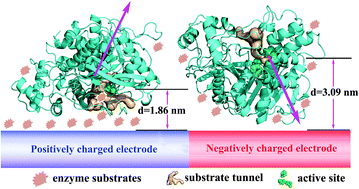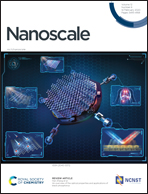Simulated revelation of the adsorption behaviours of acetylcholinesterase on charged self-assembled monolayers†
Abstract
An acetylcholinesterase (AChE)-based electrochemical biosensor, as a promising alternative to detect organophosphates (OPs) and carbamate pesticides, has gained considerable attention in recent years, due to the advantages of simplicity, rapidity, reliability and low cost. The bio-activity of AChE immobilized on the surface and the direct electron transfer (DET) rate between an enzyme and an electrode directly determined the analytical performances of the AChE-based biosensor, and experimental studies have shown that the charged surfaces have a strong impact on the detectability of the AChE-based biosensor. Therefore, it is very important to reveal the behaviour of AChE in bulk solution and on charged surfaces at the molecular level. In this work, the adsorption orientation and conformation of AChE from Torpedo californica (TcAChE) on oppositely charged self-assembled monolayers (SAMs), COOH-SAM and NH2-SAM with different surface charge densities, were investigated by parallel tempering Monte Carlo (PTMC) and all-atom molecular dynamics simulations (AAMD). Simulation results show that TcAChE could spontaneously and stably adsorb on two oppositely charged surfaces by the synergy of an electric dipole and charged residue patch, and opposite orientations were observed. The active-site gorge of TcAChE is oriented toward the surface with the “end-on” orientation and the active sites are close to the surface when it is adsorbed on the positively charged surface and the tunnel cost for the substrate is lower than that on the negatively charged surface and in bulk solution, while for TcAChE adsorbed on the negatively charged surface, the active site of TcAChE is far away from the surface and the active-site gorge is oriented toward the solution with a “back-on” orientation. It suggests that the positively charged surface could provide a better microenvironment for the efficient bio-catalytic reaction and quick DET between TcAChE and the electrode surface. Moreover, the RMSD, RMSF, dipole moment, gyration radius, eccentricity and superimposed structures show that only a slight conformational change occurred on the relatively flexible structure of TcAChE during simulations, and the native conformation is well preserved after adsorption. This work helps us better comprehend the adsorption mechanism of TcAChE on charged surfaces and might provide some guidelines for the development of new TcAChE-based amperometric biosensors for the detection of organophosphorus pesticides.

- This article is part of the themed collections: 2020 Nanoscale HOT Article Collection and Theoretical Modelling at Nano-bio Interfaces


 Please wait while we load your content...
Please wait while we load your content...